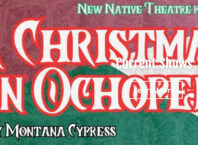
Review by Deborah Locke
It seems fair to conclude that most of us pay heed to a daylit sky: is the sun shining, is snow predicted, when is sunset?
“Spirits Dancing – The Night Sky, Indigenous Knowledge, & Living Connections to the Cosmos” brings to life the science and cultural significence of an active cosmos complete with 400 billion stars. Read this book and you may yearn to see a clear night sky with its pinpoints of light, some of them dancing. Then, you’ll act on that impulse. Read this book and for sure, your views of the night sky will be enriched, layered and never the same.
“Spirits Dancing” by Travis Novitsky (Grand Portage Ojiwbe) and Annette Lee is a treasure trove of gorgeous night images taken near Grand Portage, Minnesota. Lee, an astrophysicist, explains the science of the northern lights – the way the sun and earth’s magnetic fields interact to produce the dramatic light that transforms the night sky into a massive kaleidoscope of movement. She succinctly tells the evolution of Western thought that ultimately concludes that the light show is caused by electricity.
Lee’s overview provides a good prologue for the heart of the book which is the interpretation of a night sky by Indigenous people. Whereas Western scientists use measurement and theory to explain natural phenomena, native perspectives see the night sky “not solely as an abstract collection of facts that exists externally to be measured, but rather like a close relative who exists nearby and whose influence is vast.”
For example, the Ojibwe view the Milky Way (“Jiibay Ziibi”) as the place where spirits return to the stars. The Dakota describe the northern lights as “spirits dancing.” Some Dakota believe that humans originated with the stars, and eventually return to them. The route their spirits take is on the Wanagi Thacharjku, the Road of the Spirits (Milky Way).
The Dene natives, who live from Alaska to Hudson Bay, Canada, connect the appearance of the northern lights with large herds of caribou on the ground. That is, the lights are a signal that earth bound caribou are moving. Lee writes: “The interconnectedness of all living beings and the participatory relationship with sky and Earth are cornerstones of Indigenous science and ways of knowing.”
Years ago, I saw the Aurora Borealis in a late-night sky near St. Cloud, Minnesota. The lights resembled a massive velvet purple curtain that shimmered and flowed. It was breathtaking. The book gives recommendations on locating the northern lights, a goal requiring patience and the ability to stay awake into the early hours of the morning.
Novitsky’s accounts of his late-night trips in search of a night sky suggest that sometimes it’s hard to tell who finds who. Do we find the enveloping night sky, or did it find us?
Novitsy’s exquisite photos prefaced by Lee’s mini astronomy lesson explain the dancing sky I once saw and will never forget.






